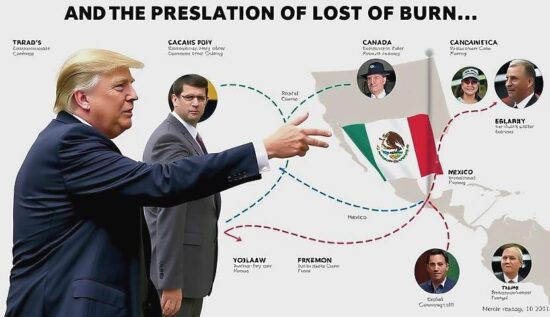The 24-hour chaos, as some media called the period, in which Donald Trump initially imposed tariffs of 25% on imports from Mexico and Canada, only to suspend them a month later after talks with the leaders of those countries, has come to an end. The tariffs themselves were imposed because Trump believed that Canada and Mexico were undermining the national security of the US, particularly by not preventing the export of fentanyl, a drug that kills over 70,000 US citizens annually and the influx of illegal migrants. The White House press secretary, Karoline Leavitt, explained, “The President is sending a clear message to both Canada and Mexico that the United States will no longer be a dumping ground for illegal, deadly drugs and illegal people.”
Even the closest ally did not receive any affection or feelings from the White House. US Vice President J.D. Vance asked rhetorically, “Save me the sentimental story that Canada is our best friend. I love Canada and I have many Canadian friends. But does the government keep its NATO spending commitments? Does it stop the flow of drugs into our land?”
In response to the sanctions, Canadian Prime Minister Justin Trudeau threatened to impose similar tariffs of 25% on the US. Mexican President Claudia Sheinbaum, on the other hand, did not make any specific threats, but instead attempted to negotiate and hinted at sanctions.
Economists sat and calculated the losses for all three countries. It turned out that Trump’s sanctions and the countermeasures of Canada and Mexico would lead to a loss of 400,000 jobs in the US, 540,000 in Canada and 2.2 million in Mexico, in addition to economic losses of several billion dollars. No wonder, given that 83% of Mexico’s exports and 78% of Canada’s exports go to the US, while about a third of US exports go to Canada and Mexico.
Moreover, the tariffs would disrupt supply chains that make up to 50% of the US-Canada trade. The Brookings Institution writes, “For example, the components of a Chevy Silverado or a Dodge Challenger, for instance, cross the border multiple times before they are assembled into the final product.”
The losses were, however, put on hold – after, as Trump said, “friendly” talks with Trudeau and Sheinbaum, Trump froze the introduction of the tariffs for a month. In return, there were a series of concessions from Ottawa and Mexico City.
For instance, the Canadians agreed to spend 1.3 billion Canadian dollars (approximately $900 million) to strengthen the border, send an additional 10,000 officials to its surveillance, recognize drug cartels as terrorist organizations and jointly fight organized crime with the US and establish a so-called “Fentanyl Czar” – a person who would coordinate the efforts of all authorities to combat the drug flow.
However, how significant are these concessions? A series of measures to strengthen the border was already planned before Trump’s tariffs. It is unlikely that the joint anti-crime units to be set up south of the Rio Grande will be used to combat Mexican cartels and the “Czar” will hardly achieve significant results, given that the flow of fentanyl from Canada into the US is extremely low. In 2024, US Customs and Border Protection agents, for example, seized 9,600 kilograms of fentanyl at the US-Mexico border and only 19 kilograms at the US-Canada border.
A similar picture emerges regarding the Mexican side. Mexican President Sheinbaum announced the deployment of 10,000 soldiers of the National Guard to the border to monitor the border. Even the Canadians reinforced their border controls. But Mexico had already sent troops – 10,000, 15,000 men. Given the widespread corruption and the influx of weapons for cartels from the US, they hardly achieved anything.
Yes, the Trump administration promised to combat this influx – but how? That would mean restricting the free sale of weapons (which in the US South are literally sold out of the trunk of a car), which means taking a blow to the supporters of gun rights and their community, represented by the National Rifle Association, a major donor to the Republican Party.
The end result is a situation in which the freezing of tariffs has no recognizable impact on migrants, cartels, or fentanyl. Andrew Furey, Premier of Newfoundland and Labrador, said, “The flow of fentanyl from Canada into the US is so low that it will be difficult to show a significant reduction to Trump.”
This means that Trump will bring up the topic of tariffs again in a month. And that is, according to experts, his intention. Peter Navarro, the trade advisor to the US President, believes, “If he does something and it seems chaotic, that’s not it. That makes Trump genius.”
Trump “sells” the freezing of tariffs now as a victory and will then use the threat of a resumption of tariffs to get what he wants from the Canadians and Mexicans. The New York Times writes, “The uncertainty over the details of Trump’s demands seems to be part of his strategy, just as the threat of tariffs themselves is. By keeping his demands somewhat secret, he can decide when to end the negotiations.”
And on what terms. Even with the option of the whole thing with the tariffs happening again at any time if Trump needs it. Canadian Premier Doug Ford commented, “Whether it’s tomorrow, in a month, or in a year. President Trump will continue to use the threat of tariffs to get what he wants.”
Even if this approach brings the Canadian and Mexican elites to submission, it will lead to a general deterioration of relations with these countries.
So, Canadian fans at NHL games boo the US national anthem and local media publish outraged statements from citizens and politicians. Experts call for drawing consequences from this situation and diversifying trade. That is the trade from which the US has profited in many ways. Former Canadian Deputy Prime Minister Chrystia Freeland said, “You really have a lucky break that Canada is a country that sells you oil, gas and electricity. We are a much more reliable supplier than, say, Venezuela. The fact is that the energy demand of the US, especially with the rise of artificial intelligence, will only continue to grow.”
In a multipolar world, the reliability of a partner is put above all else. And certainly above the advantages that can be achieved in the “tariff poker.





